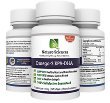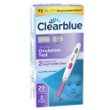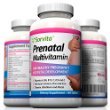What are antral follicles and what antral follicle count will tell you
In addition to FSH- and AMH-information, there is one more simple test which you should get done to get a good picture of how many eggs you have left and how many fertile years you have ahead of you. It is called “Antral follicle count”.
Welcome to the world of antral follicles
It is really a shame that one natural, simple process and one simple, beautiful test got such ugly names. Antral follicles. Antral follicle count.
That’s what often happens when scientists or medical doctors are given a chance to name something. They give names which no one can start something with (and sometimes they just give numbers). So most normal women will only recognize the word “count” and will not have the faintest idea of what should be counted.
This is a pity, since an antral follicle count is something so simple and yet so powerful that every woman who cares about her fertility must know about it. So what is the meaning of antral follicle count?
Translated into everyday English, antral follicle count answers the question (but needs to be backed up by FSH and AMH numbers): What is the time on your personal biological clock? Are you ahead of other women of your age in the number of eggs you have? Or behind them? – a small percentage of women will have their ovaries depleted of eggs before they reach the age of 30. Just in case you belong to that group, this is information you need to have in order to plan your life and career accordingly.
The sad truth is the epidemic dimension of infertility faced by women over thirty-five today represents, to some extent, a self-inflicted problem (if you are 40 or above and trying to get pregnant, please read this post).
Basically, every infertile woman was once fertile. At the age of twenty, only about 1–2% of women are infertile. At the age of forty-five, only about 1% of women can naturally get pregnant and deliver a healthy baby. Meaning, within about 20 years, the chance that you will face infertility goes from 1% to 99%. Still, we live and plan our lives, education, and careers anticipating those lucky women having babies at 40 and above would be us.
How to tell what the time is on your personal biological clock?
It is very easy and your gynecologist should be able to help you with this.
Two things are necessary: some basic knowledge on counting antral follicles and a bit better ultrasound equipment that can count structures of only one to two mm in diameter.
Now, I will explain what you need to understand yourself about the process of egg maturation, so that you can better communicate to your doctor what you want to be done.
I told you already that a woman enters puberty with about 300,000–400,000 eggs, which can potentially turn into babies. Those eggs decay at a rate of about 1,000 or more per month (in young women, actually faster) until, at some point, the egg reserve dips down to about 25,000 eggs. This typically occurs by about the age of thirty-seven.
This small remainder does not have the same fertilization potential as the eggs of that same woman when she was fifteen years younger. Chromosomal aberrations, recurrent implantation failures and miscarriages, incapability to build embryos with sperm of a partner with a mild sperm disorder – these are all likely the readouts of the same problem: deteriorating egg reserve and poor quality of the remaining eggs.
Where do the antral follicles come into play?
Antral follicles reside in your ovaries, at all times. Some die every day, and the new ones come to replace them. Every day, that is important to remember. Not dependent on the ovulation, hormones, or any other parameter of your menstrual cycle.
Over the years, science has learned that women’s ovaries can no longer be placed into the category of a “resting organ”, in which only rarely one single event occurs – the maturation of the ovulating egg.
This outdated picture had partially to do with cultural expectations of women’s bodies being passive and receptive, and many doctors lacking the technology to spot the tiny one- to two- mm bubbles during a regular trans-vaginal ultrasound examination. Actually, a good way to think of your ovaries is to imagine them as continuously boiling pots of gold – very dynamic and in constant motion.
As the matter of fact, about thirty to forty egg cells wake up in the ovaries of any young woman every day and make themselves on a long journey of egg maturation. As women get older, there will be less and less antral follicles being created every day. The ovaries will decrease in activity and their surface will appear much more quiet.
What exactly triggers this process and why so few are chosen among the hundreds of thousands of their twin sisters resting in the ovary, is still unknown. I personally like to think about it as a wonder of life and hardly feel comfortable to think beyond that point.
This is so important to grasp that I will say it again: The process of egg maturation continues throughout the entire fertile life of a woman, every single day. It is not influenced by the hormones of the menstrual cycle, or by a women being pregnant, or taking a birth control pill.
At some point, these follicles grow to one- to two- mm in size and have to make one important decision:
Is it time for them to continue growing and try to become an ovulating egg?
For most days of your menstrual cycle, the answer will be NO.
Why? Because your body is either preparing for its next ovulation (with the group of follicles which was more lucky to be selected), or is menstruating, or otherwise busy, so those little one to two mm follicles will all die.
The new ones will take their place, but if the time in the cycle is not right, then they will die, too.
On the day when your menses starts, the body understands: Oh, I am not pregnant! Never mind, let’s try again! In that moment, FSH will rise, and its increase will come as a rescuing signal for the current bunch of one- to two-mm antral follicles. They will now enter the maturation process and compete to become the ovulating egg. This process will take another ten to twelve days.
The next group of antral follicles which arrives on the next day will of course die because, for them, the FSH surge will not have the sufficient intensity anymore. The bottom line is, antral follicles can be seen on the surface of your ovaries every day (best is to look for them towards the end of the cycle) and with a little help of your gynecologist you can easily find out how active your ovaries are.
Supplements which are scientifically proven to increase egg quality:
To know when you ovulate:
Prenatal vitamins:












